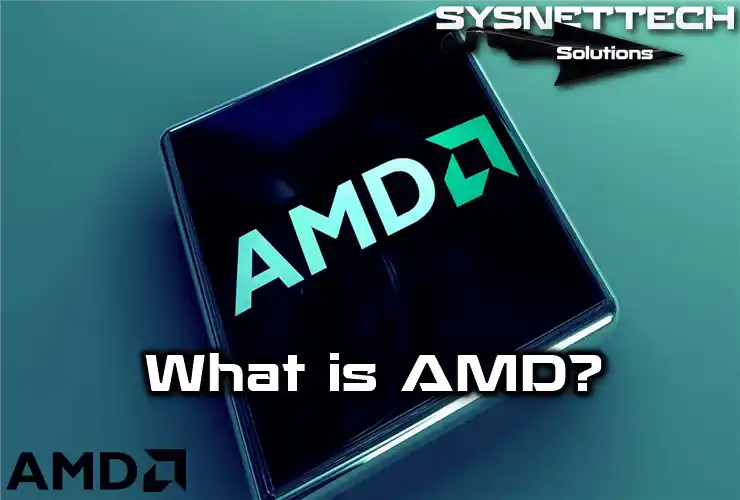In collaboration with Intel, Advanced Micro Devices, Inc. (AMD) dominates the global market for x86-compatible microprocessors.
AMD takes pride in its leadership role as a manufacturer of CPU, GPU, chipsets, and other semiconductor devices. In short, Advanced Micro Devices, Inc. (AMD), partnered with Intel, dominates the global market for x86-compatible microprocessors.

What is The Advanced Micro Devices (AMD)? What is its History and Evolution?
Recent advancements in chip manufacturing have shaped humanity’s evolution, particularly in electronics. Continuous developments have driven progress in integrated circuits. These circuits are now ubiquitous, making life without them inconceivable.
The microprocessor is one of the most outstanding achievements of the 20th century. These are bold words, and such a statement a quarter-century ago seemed absurd. But, every year, the microprocessor approaches the center of our lives. It occupies one after another at the core of a machine.
Its presence began to change how we perceive the world and ourselves. As time progresses, it becomes harder to overlook the microprocessor. It is no longer a mere product in a series of technological advancements.
Despite the microprocessor’s widespread presence, we overlook the tiny machines we encounter daily. Gradually integrated into our lives, these little silicon chips have a significant impact. They remind us of the marvels they are and the meaning they bring.
In summary, despite the microprocessor’s ubiquity, we ignore the tiny machines we encounter daily. But, as they integrate into our lives, these little silicon chips have a profound impact. They serve as a reminder of their marvel and the significance they hold.
History of AMD
On May 1, 1969, a team from Fairchild Semiconductor launched Advanced Micro Devices. The team members included Jerry Sanders III, Ed Turney, John Carey, Sven Simonsen, Jack Gifford, Frank Botte, Jim Giles, and Larry Stenger.
The company began producing integrated circuits. In 1975, it ventured into the RAM business. Intel created a clone of the 8080 microprocessor that same year using reverse engineering techniques.
During this period, the company designed and produced a series of Bit slicers. These included Am2901, Am29116, and Am293xx, which are widely used in microcomputer designs. During this time, he tried to change the perception of RISC with AMD29k processors. He tried diversifying by introducing EPROM memories, graphics, and video drivers.
It was successful in the mid-1980s with AMD7910 and AMD7911. These units were among the first to support various Bell and CCITT standards, operating at 1200 baud half-duplex or 300/300 full duplex. Despite this success, AMD29k survived as an embedded processor. Additionally, Spansion’s spin-off emerged as the leader in flash memory production.
AMD opted for a different approach, concentrating solely on Intel-compatible microprocessors. It positioned them as direct competitors in the flash memory market. On July 24, 2006, they made a significant announcement. AMD acquired ATI Technologies for $4.3 billion in cash and $58 million in shares, totaling $5.4 billion.
Internal Microprocessor
The modern microprocessor holds around 20 million transistors. Each finished chip results from more complex processes than the Manhattan Project, which created the atomic bomb.
But, even with a refined production process, they produce microchips at a rate of over 1 billion per year. To put this complexity in perspective, imagine that every small microprocessor is as complex as a medium-sized city. It includes power, telephone, drainage, buildings, streets, and houses.
None of the surprising statistics used are exceptional. The total number of transistors in all microchips equals the raindrop count. Furthermore, this comparison highlights an astonishing fact.
AMD and Intel
Advanced Micro Devices ignites passion within the personal computer industry. Comparisons of Athlon, PIII, and PIV that check their performance across diverse scenarios fill the web. Furthermore, discussions among Intel and AMD fans thrive on hardware forums.
Jerry Sanders and seven others founded AMD in 1969. In its first five years, the company focuses on redesigning and developing products from other companies. It also dedicates itself to offering extended warranties for its end product. Until the fifth year, it already had 1,500 employees and a turnover of $26.5 million. AMD and Intel signed a license exchange agreement on intellectual property in 1976. In 1985, the company became one of the 500 most valuable companies in the world.
During the era of 386 and 486 microprocessors, AMD had a straightforward aim. They aimed to copy Intel products, make minor design optimizations, and provide higher MHz. As a result, they could introduce their products at a reduced cost. Moreover, this period saw several instances involving Intel.
The illegal policy of AMD resulted in Am386 and Am486. These processors gained popularity, reaching about 30% market share. The stability of the company’s products at that time was the same as that of Intel products.
The Pentium’s departure disrupted AMD’s plans, breaking schemes. With its micro, superscalar architecture, new features emerged: individual level 1 (L1) cache, pipeline FPU, and 64-bit bus. The x86 (PC) market also introduced dynamic branch prediction and multi-threaded capabilities. These advancements would soon become essential for users.
Pentium Patent
Intel patented Pentium from the bottom up, so copying the design was no longer possible.
Due to this situation, AMD worked hard with K5, including improved Pentium, 24KB L1, 8KB for data, and 16KB for instructions. In October 1996, they released the K5 processors. Moreover, their performance was almost equal to that of the Pentium processors at the same clock speed.
When the Pentium reached 200 Mhz, the K5 did not get more than 133 Mhz. As a result, it used a number by naming its microprocessors using the “PR” or “Performance Rating” index. Furthermore, according to the company, the K5 PR166 performs like Pentium 166 Mhz.
In this way, users who were unaware of this fact when buying a PR166 thought they were getting a CPU that worked at 166 Mhz while it was 116 Mhz. So, during the K5 period, AMD experienced a decline in market share and performance competitiveness compared to Intel. As a result, it became one of their worst periods.
After the K5 failed, he needed a decent design to return to the stage and compete with Intel. But that would take many years, so he decided to buy NexGen for about $800 million and optimize Nx686. The company saw Nx686 as a fast and cheap saving, developed it, and became the K6.
The K6 chip improved over the classic Pentium and Pentium MMX. It was comparable to the Pentium II in terms of advancements.
K6 Processor
Intel had a top-of-the-line with the K6 and K6-233Mhz. However, it reversed the situation by introducing Pentium II in the summer of 1997.
They introduced the K6-2 with a minor frequency of 300 MHz in May 1998. Furthermore, they brought many improvements, including the 100Mhz FSB and AGP x2. They also introduced the Super 7 platform and a double superscalar unit to execute MMX instructions.
Since Pentium II could not compete with the K6-2, Intel introduced Celeron as a low-cost, market-oriented processor. The K6-2 dominated it—moreover, the K6-2’s level 2 cache operated at 100Mhz—the same speed as the FSB.
On the other hand, the L2 cache of a Pentium II in the cartridge ran at half the micro Mhz. It made the K6-2s comparable to a PII up to 350 Mhz in general-purpose applications. Starting from 350Mhz, the PII continued to scale in performance. Meanwhile, the K6-2s were stagnant and could hardly enjoy the improved frequency as their L2 cache operated at 100 MHz.
In February 1999, the company introduced the K6-3 with 256KB L2 integrated into the chip. General-purpose performance improved significantly. However, FPU improvement was less significant due to FPU operations’ cache resistance. Moreover, the 400Mhz K6-3 competed with the 500Mhz Pentium III in general-purpose applications but lost in the FPU.
The K6-3 would be an excellent success for AMD if it did not have the many production issues it offers. AMD’s first L2 on-die microphone and inexperience in the subject were costly. Like all memories, the K2-3 organizes its L2 cache by row and column, resembling a spreadsheet.
K7 Processor
If a specific memory area is faulty, all memory becomes useless. It is so if you need advanced systems that map the defective memory areas to another site without errors. AMD sold the K6-3 processors that did not meet the quality standards of K6-2.
They turned off the L2 cache. Consequently, this allowed for better use of resources and increased product availability. When turning off the L2 cache, there was no difference between K6-2 and K6-3.
Despite the retail success of the K6 series, AMD has been missing for years. Hence, AMD launched the processor, the K7, which revealed the most expectations. According to many analysts, K7 or Athlon meant living or dying.
After Socket 7, AMD could not use any Intel platform. Thus, it had to create its infrastructure. It is a tricky thing, so AMD has decided to take the rights of EV6. Additionally, it is the latest generation of Alphas and the FSB used by Alfa 21264.
Athlon debuted in June 1999 and exceeded all expectations. For the first time, an AMD processor beat Intel’s most powerful chip from any angle. When they released Athlon in Slot A format, it surpassed the faster Pentium III by 50 MHz.
It ran specifically at 500M, 550M, 600M, and 650 MHz speeds. Athlon outperformed FPUs by 10-40%. It also beat the same MHz Pentium III by 15%. Integer applications showed this performance benefit.
AMD’s innovative chip architecture improved Athlon’s performance. 128KB L1 is the most enormous Layer 1 cache. The DDR super segment pipeline is 200 Mhz. The sophisticated EV6 Bus (FSB) dual-port x86 has 512KB L2. Also, it allows high clock frequencies. Athlon has the first 3-unit x86 superscalar and segmented FPU. It expands AMD’s 3DNOW segmented FPU.
Athlon Improvements
It was combining the L1 cache four times the size of PIII’s L1 showcased improvements. It revealed Athlon’s much-improved bus compared to GTL of PIII. As a result, Athlon demonstrated superior performance over Pentium III. Moreover, Athlon featured a more advanced FPU compared to Pentium III. It ran twice the frequency while offered at a lower price point.
AMD and Intel introduced more Mhz versions of star chips as time passed. It was a crazy Mhz race that AMD always won by getting a 50 Mhz version from Intel. But, this constant competition pushed innovation.AMD emerged as the winner of the race designed to reach Gigahertz.
AMD/ATI: After completing the ATI acquisition in 2006, AMD underwent restructuring. So, it became the only company to offer solutions in all branches. Consequently, AMD gained a competitive edge in the market. Additionally, AMD is the world’s largest producer of chips for TVs, consoles, and mobile phones. As a result, this positions AMD as Intel’s biggest competitor in semiconductor solutions today.




Como se utiliza AMD en la actualidad y su cresimiento havia el AI? Y cuales son las expectstivas de cresimiento en el presente.
Gracias
Rosa
San Juan Puerto Rico